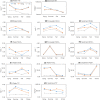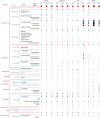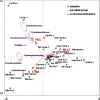Illumina sequencing-based analysis of sediment bacteria community in different trophic status freshwater lakes
- PMID: 28173613
- PMCID: PMC5552931
- DOI: 10.1002/mbo3.450
Illumina sequencing-based analysis of sediment bacteria community in different trophic status freshwater lakes
Abstract
Sediment bacterial community is the main driving force for nutrient cycling and energy transfer in aquatic ecosystem. A thorough understanding of the community's spatiotemporal variation is critical for us to understand the mechanisms of cycling and transfer. Here, we investigated the sediment bacterial community structures and their relations with environmental factors, using Lake Taihu as a model system to explore the dependence of biodiversity upon trophic level and seasonality. To combat the limitations of conventional techniques, we employed Illumina MiSeq Sequencing and LeFSe cladogram to obtain a more comprehensive view of the bacterial taxonomy and their variations of spatiotemporal distribution. The results uncovered a 1,000-fold increase in the total amount of sequences harvested and a reverse relationship between trophic level and the bacterial diversity in most seasons of a year. A total of 65 phyla, 221 classes, 436 orders, 624 families, and 864 genera were identified in the study area. Delta-proteobacteria and gamma-proteobacteria prevailed in spring/summer and winter, respectively, regardless trophic conditions; meanwhile, the two classes dominated in the eutrophication and mesotrophication lake regions, respectively, but exclusively in the Fall. For LEfSe analysis, bacterial taxon that showed the strongest seasonal or spatial variation, majority had the highest abundance in spring/summer or medium eutrophication region, respectively. Pearson's correlation analysis indicated that 5 major phyla and 18 sub-phylogenetic groups showed significant correlation with trophic status. Canonical correspondence analysis further revealed that porewater NH4+ -N as well as sediment TOM and NOx -N are likely the dominant environmental factors affecting bacterial community compositions.
Keywords: Illumina Sequencing; Lake Taihu; bacteria communities and biodiversity; sediment; trophic status of aquatic ecosystem.
© 2017 The Authors. MicrobiologyOpen published by John Wiley & Sons Ltd.
Figures








Similar articles
-
Spatiotemporal variation of planktonic and sediment bacterial assemblages in two plateau freshwater lakes at different trophic status.Appl Microbiol Biotechnol. 2016 May;100(9):4161-75. doi: 10.1007/s00253-015-7253-2. Epub 2015 Dec 28. Appl Microbiol Biotechnol. 2016. PMID: 26711281
-
Distinctive Patterns in the Taxonomical Resolution of Bacterioplankton in the Sediment and Pore Waters of Contrasted Freshwater Lakes.Microb Ecol. 2018 Apr;75(3):662-673. doi: 10.1007/s00248-017-1074-z. Epub 2017 Sep 17. Microb Ecol. 2018. PMID: 28920165
-
Temporal and Spatial Dynamics of Sediment Anaerobic Ammonium Oxidation (Anammox) Bacteria in Freshwater Lakes.Microb Ecol. 2017 Feb;73(2):285-295. doi: 10.1007/s00248-016-0872-z. Epub 2016 Oct 10. Microb Ecol. 2017. PMID: 27726034
-
A guide to the natural history of freshwater lake bacteria.Microbiol Mol Biol Rev. 2011 Mar;75(1):14-49. doi: 10.1128/MMBR.00028-10. Microbiol Mol Biol Rev. 2011. PMID: 21372319 Free PMC article. Review.
-
Dead or alive: sediment DNA archives as tools for tracking aquatic evolution and adaptation.Commun Biol. 2020 Apr 7;3(1):169. doi: 10.1038/s42003-020-0899-z. Commun Biol. 2020. PMID: 32265485 Free PMC article. Review.
Cited by
-
Insights in Pharmaceutical Pollution: The Prospective Role of eDNA Metabarcoding.Toxics. 2023 Nov 5;11(11):903. doi: 10.3390/toxics11110903. Toxics. 2023. PMID: 37999555 Free PMC article. Review.
-
Sediment bacterial biogeography across reservoirs in the Hanjiang river basin, southern China: the predominant influence of eutrophication-induced carbon enrichment.Front Microbiol. 2025 Mar 28;16:1554914. doi: 10.3389/fmicb.2025.1554914. eCollection 2025. Front Microbiol. 2025. PMID: 40226101 Free PMC article.
-
Biomass addition alters community assembly in ultrafiltration membrane biofilms.Sci Rep. 2020 Jul 14;10(1):11552. doi: 10.1038/s41598-020-68460-x. Sci Rep. 2020. PMID: 32665605 Free PMC article.
-
Spatial and Seasonal Variations in the Abundance of Nitrogen-Transforming Genes and the Microbial Community Structure in Freshwater Lakes with Different Trophic Statuses.Int J Environ Res Public Health. 2019 Jun 28;16(13):2298. doi: 10.3390/ijerph16132298. Int J Environ Res Public Health. 2019. PMID: 31261730 Free PMC article.
-
A Review and Perspective of eDNA Application to Eutrophication and HAB Control in Freshwater and Marine Ecosystems.Microorganisms. 2020 Mar 16;8(3):417. doi: 10.3390/microorganisms8030417. Microorganisms. 2020. PMID: 32188048 Free PMC article. Review.
References
-
- Aizaki, M. (1981). Application of modified Carlson's trophic state index to Japanese lakes and its relationships to other parameters related to trophic state. National Institute for Environmental Studies, Japan, 23, 13–31.
-
- Bartosch, S. , Hartwig, C. , Spieck, E. , & Bock, E. (2002). Immunological detection of Nitrospira‐like bacteria in various soils. Microbial Ecology, 43, 26–33. - PubMed
-
- Bauer, M. , Kube, M. , Teeling, H. , Richter, M. , Lombardot, T. , Allers, E. , … Glockner, F. O. (2006). Whole genome analysis of the marine Bacteroidetes'Gramella forsetii’ reveals adaptations to degradation of polymeric organic matter. Environmental Microbiology, 8, 2201–2213. - PubMed
Publication types
MeSH terms
Substances
LinkOut - more resources
Full Text Sources
Other Literature Sources

